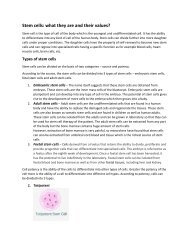Stem cells: what they are and their values?
These stem cells can treat diseases by regenerating themselves into daughter stem cells which further replace the damaged cells of the body to repair the tissues and organs.
These stem cells can treat diseases by regenerating themselves into daughter stem cells which further replace the damaged cells of the body to repair the tissues and organs.
Create successful ePaper yourself
Turn your PDF publications into a flip-book with our unique Google optimized e-Paper software.
Reasons for choosing cord blood stem <strong>cells</strong> for treatment<br />
Children with blood-related disorders such as leukemia <strong>and</strong> inherited blood diseases like Fanconi's<br />
anemia <strong>are</strong> used for the treatment of cord blood. The patient who is suffering from these types of<br />
diseases is first provided with chemotherapy to destroy the damaged <strong>and</strong> diseased <strong>cells</strong> of the body.<br />
Then the young <strong>and</strong> undifferentiated stem <strong>cells</strong> <strong>are</strong> infused into the body of the patient. These stem<br />
<strong>cells</strong> can treat diseases by regenerating themselves into daughter stem <strong>cells</strong> which further replace the<br />
damaged <strong>cells</strong> of the body to repair the tissues <strong>and</strong> organs.<br />
Therefore, cord blood provides a beneficial option for patients when comp<strong>are</strong>d to bone marrow<br />
transplants. The process of collection of cord blood is easier than bone marrow <strong>and</strong> can be stored when<br />
frozen. The risk of immune failure <strong>and</strong> infections, including Graft <strong>and</strong> Host Disease, often seems less<br />
than bone marrow. This means that cord blood does not need to be as perfectly matched to the patient<br />
as bone marrow.<br />
Nevertheless, there <strong>are</strong> also restrictions on cord blood transplants. Cord blood c<strong>are</strong> for adults usually<br />
requires two cord blood units for treatment. Clinical studies using adult dual cord blood transplantation<br />
have shown similar results to other HSC sources, like bone marrow or peripheral blood mobilized. There<br />
<strong>are</strong> currently experiments to extend a single blood cord for adult use.





